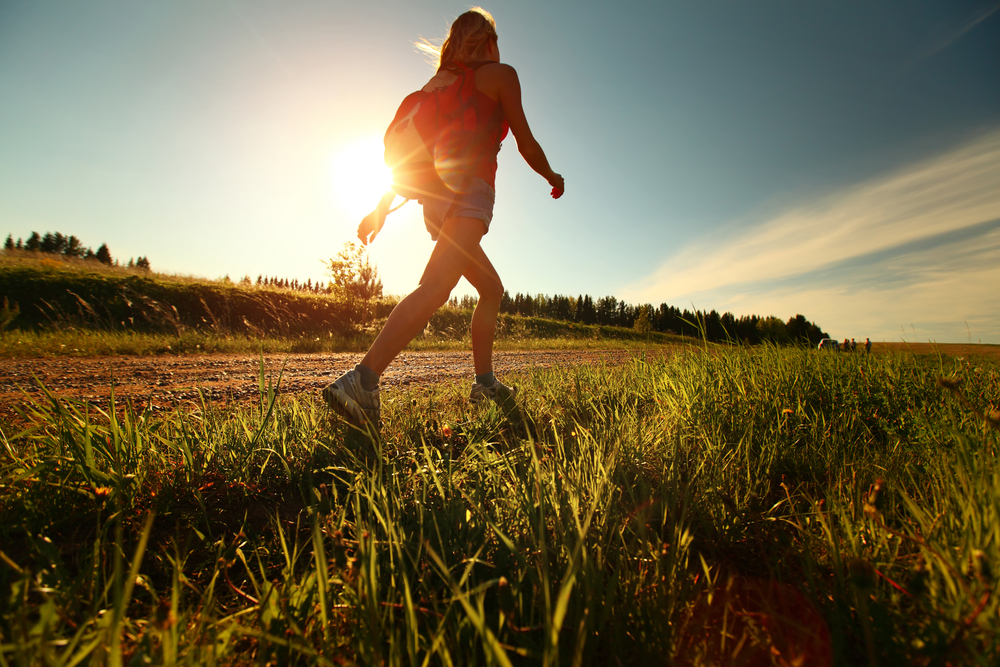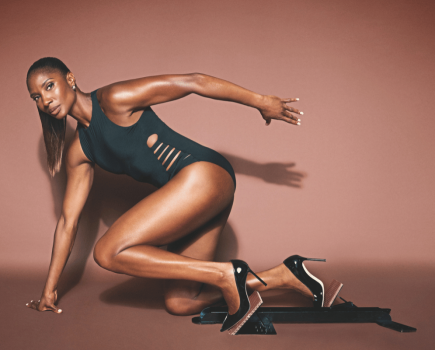With the right walking posture you can focus your energy and avoid injuries. Engaging your core and using your body properly will help boost your metabolism and help burn extra calories as you walk. Personal trainer Simon Cass shows you how…
Warm up before a long walk
It’s a good idea to warm up your spine before you set off on your walk.
- Firstly, jog or march on the spot for about a minute.
- Then, stand up straight with your hands on your hips, keeping them facing forward and rotate from the waist in both directions five times.
- Next, imagine you are between two planes of glass, and lean over to one side, then the other.
- Do this five times.
- Finally, bend forward from the waist, and then lean back five times. Don’t force anything – you will find your range of movement gradually increases if you stick with it.
Keep checking your walking posture
In an ideal world, once you had set yourself in the right posture, you would stay like that… forever! But this isn’t likely, so whenever you have a natural break, check how you’re doing. Pausing before you cross the road? Take a deep breath and stretch your spine. Stopping to take a drink? Make sure your shoulders are relaxed when you pick your bag back up and set off again. Frequent checks like these, whether it’s a long walk or you’re just popping round to the shops, will help you stay problem free.
Stop neck strain as you walk

Keep your head up and look to the horizon. If you spend your time looking at your feet as you walk this puts more stress on your neck muscles and can lead to postural problems. In contrast, looking into the distance is good for your eyesight, and counteracts long periods of looking at phones or screens.
You can also do some neck exercises to help keep the correct alignment.
- Starting in an upright posture with hands on your hips, tuck your chin to your chest, hold then tilt it back as far as it will go.
- Then look over each shoulder, aiming to get the chin as far round as you can without discomfort.
- Finally, move your head from side to side, trying to get the ear close to the shoulder.
- Do five in each direction.
Get a flatter stomach as your walk
When walking, draw your stomach in toward your spine, and when you breathe, imagine you are breathing deeply into your tum.
Your stomach is part of your core, so pulling your muscles in in this way will help you really engage it, which will aid your balance. When you breathe deeply your muscles will become stronger, as will your diaphragm. Deep breathing also means more oxygen and more energy flowing into your muscles. In between walks, planks and push ups (as described in the shoulder section) will strengthen your stomach.
You could also try some bridge raises and abdominal bracing.
- Lay on your back with your feet flat on the floor, your hands palms down by your sides.
- Slowly raise your hips to form a wedge shape, and lower under control.
- Complete 8-15, then raise your right knee towards your chest and push against it with your right hand.
- Hold for five seconds and repeat on the other side.
Relaxed shoulders help your core strength
 Before you begin
your walk, set your shoulders in the right position. Simply stand up straight, lift your shoulders towards your ears, pull them back, then relax. Your shoulders are part of your ‘core’. Holding them correctly will help keep your chest open, so you can breathe more easily and move more efficiently. It will save your energy, enabling you to enjoy more of your walk without feeling tired.
Before you begin
your walk, set your shoulders in the right position. Simply stand up straight, lift your shoulders towards your ears, pull them back, then relax. Your shoulders are part of your ‘core’. Holding them correctly will help keep your chest open, so you can breathe more easily and move more efficiently. It will save your energy, enabling you to enjoy more of your walk without feeling tired.
Between walks you can strengthen your shoulders with simple bodyweight exercises. Try supporting your body in a plank position for about 15-30 seconds, three times. Then aim to complete three sets of 8-15 push ups, supporting yourself on your knees if necessary.
Stop back pain by strengthening your hips
Your hips keep your pelvis in the correct position, which will prevent lower-back aches and pains. To keep them strong and flexible, do some squats and lunges to cool down after and between walks. Try to do 8-15 repetitions.
To do a squat, stand tall with your feet shoulder width apart, toes forward.
- Cross your arms over your chest.
- Then hinge your hips back, and bend your knees.
- Keep your back in a neutral position.
- Try to lower yourself as deep as you can.
- Then push the hips forward again to stand.
To lunge, start in the same position as for a squat.
- Step forward in line with your hips and bend the lead knee.
- Lower yourself as far as you can, keeping the knee and foot in alignment.
- Push off the front foot to a standing position and repeat on the other side.
- After a walk, hold a squat and a lunge for about 15 seconds to stretch your hips.
How to protect your knees
If the muscles that move the knee are strong, it will help keep the joint healthy and allow you to absorb the impact of walking. Squats and lunges are great for your knees. As you do these exercises, your knee bends and this means the muscles either side of the knee are working. You can also vary your lunges by stepping to the side and to the rear. If you’re worried about your balance, hold onto a support before doing your squats and lunges.
- Feeling inspired? Take a look at our list of best walking holidays!








